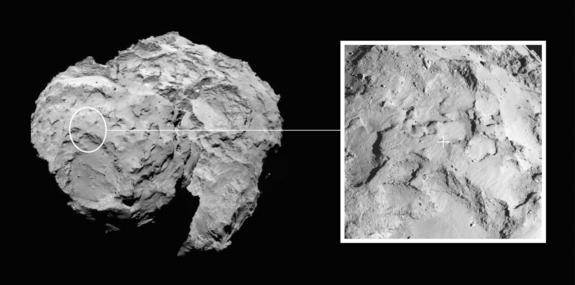| Online: | |
| Visits: | |
| Stories: |
European Spacecraft to Make Historic Comet Landing on November 12th, 2014
Wednesday, October 1, 2014 9:30
% of readers think this story is Fact. Add your two cents.

One of the boldest and most dramatic maneuvers in the history of spaceflight is just six weeks away.
The current plan calls for the lander, named Philae, to come down at a location on Comet 67P that the mission team has dubbed Site J.
“Site J was chosen unanimously over four other candidate sites as the primary landing site because the majority of terrain within a square kilometer [0.4 square miles] area has slopes of less than 30 degrees relative to the local vertical and because there are relatively few large boulders,” European Space Agency (ESA) officials said in a statement.
“The area also receives sufficient daily illumination to recharge Philae and continue surface science operations beyond the initial 64-hour battery-powered phase,” they added.
If all goes according to plan, Rosetta will deploy Philae at 4:35 a.m. EDT (0835 GMT) on Nov. 12, at a distance of 14 miles (22.5 km) from the comet. Philae will spiral down slowly toward 67P, eventually securing itself to the surface with harpoons at Site J around 11:30 a.m. EDT (1530 GMT) that same day.
 |
| This image from Europe’s Rosetta spacecraft shows the mission’s planned landing site on Comet 67P/Churyum |
Confirmation of the historic maneuver’s success or failure will come 28 minutes and 20 seconds later — the amount of time it takes for signals to travel from Rosetta to its controllers here on the ground.It’s also possible that Philae could touch down at a backup location called Site C, ESA officials said. Final confirmation of the landing plan will come on Oct. 14, after a formal review of data gathered by the Rosetta mothership. ESA will also launch a public competition to name Philae’s landing site on that date.
The $1.7 billion (1.3 billion euros) Rosetta mission blasted off in March 2004 and finally arrived in orbit around Comet 67P on Aug. 6 of this year. The Rosetta orbiter is studying the 2.5-mile-wide (4 km) comet with 11 different science instruments, and Philae will contribute by photographing 67P’s surface and collecting and analyzing samples.
Comet 67P, which takes 6.5 years to complete one lap around the sun, is now getting closer and closer to our star. Rosetta and Philae will continue to observe the comet and study how it changes as it warms up on its trek through the inner solar system.
The goal is to better understand the composition and behavior of comets, which are remnants from the solar system’s formation 4.6 billion years ago, ESA officials have said. Rosetta is expected to continue gathering data through December 2015.
Source:




